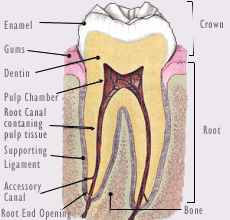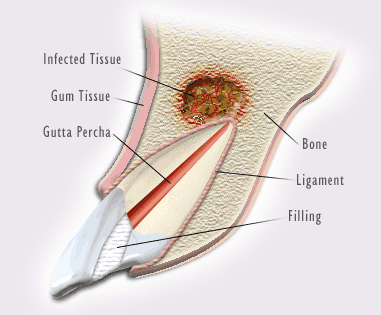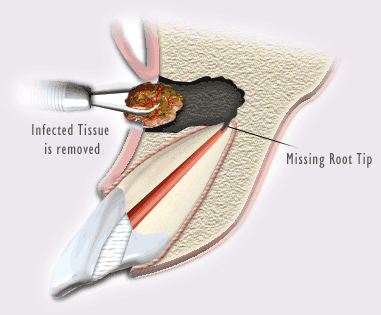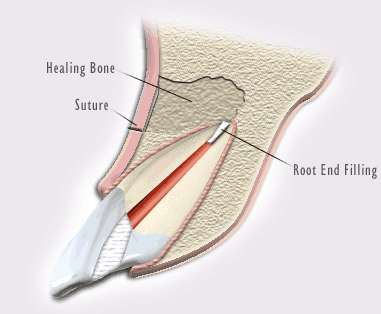Questions


Step 3: The root canals are cleaned thoroughly with the help of calibrated instruments. Radiographs are taken periodically to calculate the exact length of the root canals.

Step 4: The root canals are filled with a sterile material to prevent re-infection. The access cavity is sealed with temporary or permanent cement.

The treatment is completed by the general dentist who replaces the temporary filling by a permanent filling or a crown (cap).
All dentists, including your general dentist, receive basic training in endodontic treatment in dental school. The decision to refer cases to a specialist is based on the level of difficulty associated with a given case.
Endodontists are dentists who specialize in root canal treatment (Endodontics). After finishing their basic dental degree, Endodontists spend two to three more years studying Endodontic procedures (root canal treatment) in greater detail. They perform routine as well as difficult and very complex endodontic procedures, including retreatment of previous root canals that have not healed completely, as well as endodontic surgery. Endodontists are also experienced at finding the cause of oral and facial pain that has been difficult to diagnose.
Root canal treatment doesn’t cause pain, on the contrary, it relieves pain in many situations. You will be completely numb during the procedure. Dr.Venkat is well versed in a wide variety of anaesthesia protocols to ensure that you will feel nothing whatsoever during the procedure. You may experience some post treatment discomfort, which is manageable with over-the-counter medication.
Antibiotics cannot cure a root canal infection because the source of infection is inside the tooth where there is no blood supply. Therefore there is no mechanism to deliver the antibiotics. The cure is the complete cleaning and filling of the contaminated root canal space. However, antibiotics are indicated when there is swelling, a temperature, or other systemic signs of infections. Antibiotics may be useful to diminish symptoms such as biting pain before the root canal can be started, and may help prevent some types of post treatment pain involved with having the root canal performed.
The aim is to clean the root canal system thouroughly and this can be achived in one,two or more visits. The estimated number of visits will be discussed during the consultation appointment.
The nature and degree of discomfort experienced after root canal therapy depends upon a number of factors; the original diagnosis, your unique reaction to dental trauma, the amount of pain you had prior to treatment, and the amount of manipulation necessary to treat the tooth. A regimen of anti-inflammatories, analgesics and antibiotics may be required and should be taken as directed. The tooth is expected to be sore when chewing for up to a week after treatment. To help diminish this discomfort, the ‘bite’ on the tooth may be relieved from occlusion and you are asked to avoid the side while eating until it is comfortable again.
Once a tooth has reached a stage where root canal treatment is necessary, the only alternative is extraction (removal) of the tooth.
Saving your natural teeth, if possible, is a better option. Once a tooth is removed, it has to be replaced. In order to give a permanent replacement, one has to either go in for a bridge or an implant. Placement of a bridge or an implant will require significantly more time in treatment, cost and may result in further procedures to adjacent teeth and supporting tissues. Nothing is as good as your natural tooth. If you are not committed to having the tooth properly restored after the root canal procedure and you do not mind the thought of losing a tooth, then endodontic therapy may not be the treatment of choice for you. Sadly, extraction is a short term fix with long term consequences.
We try our best to present the full scope of what you may expect from the treatment, however, in some cases, not everything plays out as expected. It is understood that endodontic treatment is a procedure to retain a tooth which may otherwise require extraction. Although this treatment has a very high degree of clinical success, it is still a biological procedure so it cannot be guaranteed. Occasionally a tooth which has had endodontic treatment may require retreatment, surgery, or even extraction. As previously indicated, once treatment is completed, your tooth will need a final restoration (filling, cap, or crown). Our fee does not include this service.
We find out why the failure has occurred and try to correct it. The successful outcome of a root canal treatment depends on not only the filling of the root canal system, but also the health of the supporting gum and bone, as well as the integrity of the remaining natural tooth structure.
Most teeth can be treated. Occasionally, a tooth can’t be saved because the root canals are not accessible, the root is severely fractured, the tooth doesn’t have adequate bone support, or the tooth cannot be restored. However, advances in endodontics are making it possible to save teeth that even a few years ago would have been lost. When endodontic treatment is not effective, endodontic surgery may be able to save the tooth.
Unless you opt for treatment under sedation you will be able to drive back home. Root canal treatment itself will not cause any drowsiness or loss of coordination.





- The tooth and surrounding areas are anesthetized.
- A small opening is made near the tooth by reflecting the gum tissue away from the tooth.
- The infected root tip is removed.
- A small filling is placed at the root tip to seal it.
- The gum tissue will heal upon suturing.

Step 1

Step 2

Step 3
- a visible swelling inside or outside of your mouth;
- an allergic reaction to medication, including rash, hives or itching (nausea is not an allergic reaction);
- a return of original symptoms; or
- your bite feels uneven.
